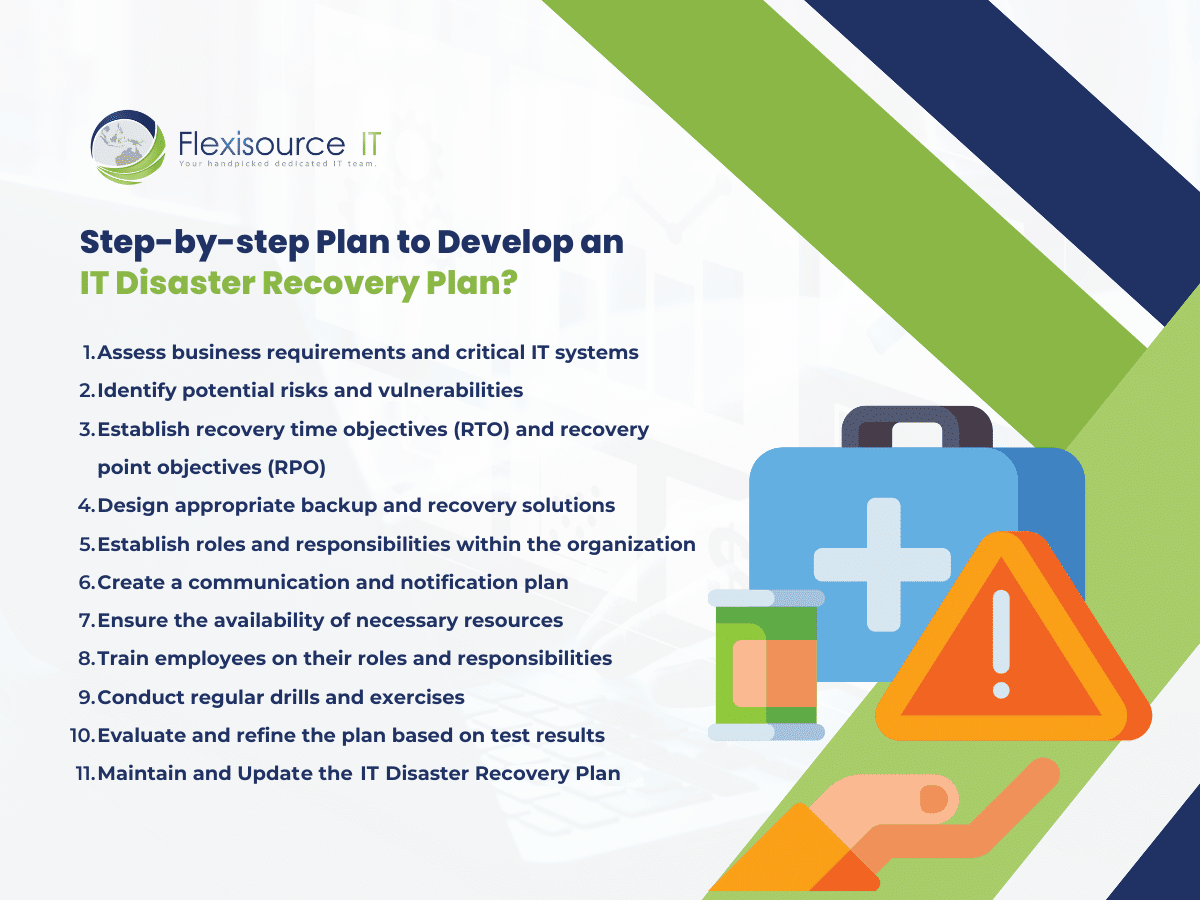In today’s interconnected world, businesses rely heavily on their IT infrastructure to effectively serve their customers. However, the ever-present threat of unforeseen events, such as natural disasters, cyberattacks, or system failures, poses a significant risk to the continuity of operations. Organisations must establish a robust IT disaster recovery plan to mitigate these risks and protect their businesses.
This article delves into the importance of an IT disaster recovery plan and the necessary steps to develop a comprehensive and effective strategy. From conducting risk assessments and business impact analyses to establishing recovery strategies and testing protocols, we will explore the essential elements of a resilient IT disaster recovery plan.
Table of Contents
What is IT Disaster, and Why does it happen?
An IT disaster is an event that can cause a disruption in the normal functioning of a business’s IT infrastructure. The common causes of IT disasters include hardware or software failure, data loss, cyber-attacks, natural disasters, and human error.
Such events can lead to significant financial losses and disruption of operations. An IT disaster can lead to data loss, financial losses, and even the complete shutdown of operations.
Therefore, organisations must understand the common causes of IT disasters so that they can prepare themselves and mitigate the associated risk. Companies must prepare for any IT disaster by having a well-defined plan and taking proactive steps to protect their systems from potential threats.
What is an IT Disaster Recovery Plan (DRP)?
An IT disaster recovery plan is a comprehensive strategy that outlines the steps and measures that employees must follow during a disruptive incident. It ensures the swift recovery of critical IT systems and processes, minimising downtime, data loss, and financial implications. It helps businesses safeguard operations, maintain customer trust, and resume normalcy after a disaster.
Likewise, here are the critical components of a disaster recovery plan.
Risk Assessment and Business Impact Analysis
Risk assessment and business impact analysis are crucial to a successful disaster recovery plan. It is the process of identifying potential risks that could affect an organisation’s operations.
At the same time, a business impact analysis is analysing the possible effects of a risk on an organisation’s operations. Knowing and understanding these two concepts can help organisations create effective disaster recovery plans tailored to their unique needs and circumstances.
Backup and recovery strategies
Backup and recovery strategies are a critical component of any disaster recovery plan. They ensure that data is backed up and stored in the event of a disaster so that it can be recovered quickly and easily. Backup and recovery strategies also involve the creation of policies and procedures to ensure that all data is backed up regularly, securely stored, and accessible in the event of a disaster. These strategies are essential for businesses to protect their data from loss or destruction in an emergency.
Communication and crisis management
Communication and crisis management are essential components of any disaster recovery plan. In the event of a natural or man-made disaster, it is crucial to have an effective communication and crisis management strategy to ensure that all stakeholders are informed and prepared for the situation.
This will help to reduce confusion, minimise disruption, and facilitate a smooth transition back to normal operations. In addition, having an effective communication and crisis management plan in place will help organisations maintain their reputation during difficult time.
How to Develop an IT Disaster Recovery Plan?
Now that you know the meaning and components of an IT disaster recovery plan, it’s time to create one for your company. Try the following steps:

Assess business requirements and critical IT systems.
Before everything else, you must evaluate your business requirements and know your critical IT systems. This is to ensure that all necessary components are taken into consideration.
Likewise, the assessment should include an analysis of the current IT infrastructure, data storage needs, backup and restoration processes, system redundancies, and other related components. It is essential to understand the specific requirements of each business and its critical IT systems to create a proper disaster recovery plan.
Identify potential risks and vulnerabilities
Next on our IT disaster recovery plan checklist is knowing any potential risks and vulnerabilities in your company and IT system. When making an IT disaster recovery plan, one must be aware of the weakness to address it before it becomes a problem.
This includes assessing data security, identifying weak points in the system, and ensuring that resources are available to respond quickly and effectively. By doing this, organisations can be sure that their disaster recovery plan is as effective as possible and will help them get back on their feet after any disaster.
Establish recovery time objectives (RTO) and recovery point objectives (RPO)
Recovery Time Objective (RTO) and Recovery Point Objective (RPO) are essential components of a successful IT disaster recovery plan. RTO is the maximum time an organisation must wait before its systems and data can be restored during a disaster. On the other hand, RPO is the maximum amount of data an organisation can afford to lose in case of a disaster.
Establishing RTO and RPO objectives helps manage expectations within and with stakeholders. It provides a common understanding of the recovery capabilities and the time required to restore operations. This ensures everyone knows the recovery timeframes and data restoration points, enabling better decision-making and communication during a crisis.
Design appropriate backup and recovery solutions
Backup and recovery solutions are essential to these plans, as they protect against data loss in an emergency. Backups allow businesses to restore their data quickly and easily. Simultaneously, recovery solutions ensure that any lost or corrupted data can be recovered. As such, companies can ensure their operations will continue running smoothly during a disaster.
Likewise, when declaring backups and recovery solutions, it is vital to consider the type of data that needs to be backed up, the frequency of backups, and the impact a disaster could have on the organisation. These factors help your company choose a backup and recovery solution that will provide a reliable and cost-effective way to protect their data in a disaster.
With the proper backup and recovery solution, organisations can be confident that their data will be safe and secure even if the worst happens.
Establish roles and responsibilities within the organisation
Having well-defined roles and responsibilities in the plan is essential to ensure everyone knows their job during an IT crisis. It also helps to ensure that all tasks are done efficiently and on time, allowing the organisation to recover quickly and minimise damage.
With clear roles and responsibilities, disaster recovery can be smooth and successful.
Create a communication and notification plan
Communication plans are an essential part of IT disaster recovery plans. It provides a framework for responding to a disaster and ensures to inform all stakeholders of the situation. Likewise, communication plans outline who needs to be contacted, what information should be shared, and how it should be communicated. This helps ensure everyone is on the same page and that potential issues can be addressed quickly and effectively.
Ensure the availability of necessary resources
Organisations must have access to the right resources and tools to develop an effective IT disaster recovery plan. As such, it is essential to maintain up-to-date documentation of your IT infrastructure, including network diagrams, hardware and software inventories, configuration details, and system dependencies. You should also include reliable backup systems, comprehensive documentation, secure offsite storage facilities, and an efficient communication system.
This documentation aids in efficient recovery efforts.
Train employees on their roles and responsibilities
Training employees on their duties for IT disaster recovery is essential to ensure the organisation is prepared for any unexpected events. It helps minimise the risk of data loss and system downtime. Likewise, it also guarantees that the organisation can recover quickly and efficiently from any IT-related disasters.
By providing employees with the necessary knowledge and skills, they can be better equipped to handle any potential issues that may arise during a disaster. This helps protect the organisation’s data and systems and improves employee morale by making them feel more confident in their ability to handle such situations.
Conduct regular drills and exercises
Regular drills and exercises are necessary to ensure the IT infrastructure can quickly recover during a disaster. They also help to identify any gaps in the system, as well as identify areas where improvements can be made. Drills and exercises also allow IT personnel to practice their skills in recovering from a disaster, so they are better prepared when it occurs.
Evaluate and refine the plan based on test results
After conducting drills and exercises, evaluating and refining your IT disaster recovery plan is crucial. This evaluation process helps identify areas of improvement and ensures that remains effective and up to date.
First, try to assess your team’s performance, systems, and processes during the drills and exercises. Look for any bottlenecks, gaps, or weaknesses that were identified. Analyse the effectiveness of your recovery strategies and the adherence to established RTOs and RPOs.
Also, you can collect feedback from participants involved in the drills and exercises, including team members, stakeholders, and external vendors. Encourage open and honest feedback about the strengths and weaknesses of the plan, as well as any observed challenges or suggestions for improvement.
Maintain and Update the IT Disaster Recovery Plan
Once you have evaluated and revised your plan, keep updating your IT disaster recovery plan documentation based on the insights gained from the evaluation. Incorporate any identified improvements, changes in technology, or lessons learned. Ensure that the plan accurately reflects the current state of your IT infrastructure and recovery procedures.
Build Your IT Disaster Recovery Plan with Flexisource IT!
In summary, an IT disaster recovery plan is essential to any business. In any unforeseen circumstances, companies can safeguard their valuable assets, minimise downtime, and ensure a swift recovery.
We hope this article helped you learn more about IT disasters and how to prevent them. And remember, n IT disaster recovery plan is not a one-time effort but an ongoing commitment to resilience and preparedness. It requires continual monitoring, updating, and testing to adapt to changing technologies, threats, and business needs. Investing the time and resources to build a robust plan will pay off in the event of a disaster. It will allow your business to recover swiftly and minimize the impact on operations.
If you need assistance in developing or implementing your IT disaster recovery plan, consider partnering with Flexisource IT. Our team of experienced professionals can provide support you need to build a tailored plan that aligns with your business. Don’t wait for the unexpected to strike – take proactive steps today to protect your business from unforeseen events.
Build your IT disaster recovery plan with Flexisource IT and safeguard your business from the unpredictable. Contact us now to get started on your journey to resilience and peace of mind.
Pamela is a full-time content writer and a lifelong Philomath. Her previous experience as a research analyst made her passionate about traveling the world and understanding how it works. During her day off, you can often find her indoors, writing stories or oil painting.


